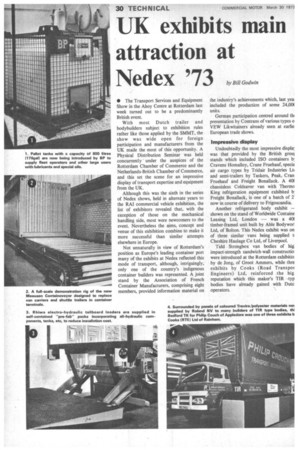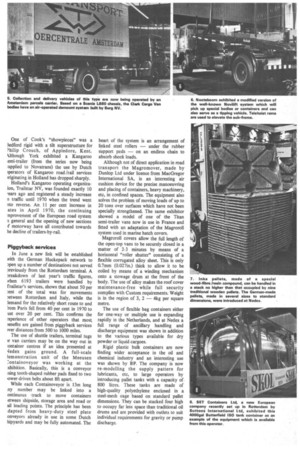UK exhibits main attraction at
Page 30

Page 31

If you've noticed an error in this article please click here to report it so we can fix it.
Nedex '73 by Bill Godwin
• The Transport Services and Equipment Show in the Ahoy Centre at Rotterdam last week turned out to be a predominantly British event.
With most Dutch trailer and bodybuilders subject to exhibition rules rather like those applied by the SMMT, the show was wide open for foreign participation and manufacturers from the UK made the most of this opportunity. A Physical Distribution Seminar was held concurrently under the auspices of the Rotterdam Chamber of Commerce and the Netherlands-British Chamber of Commerce, and this set the scene for an impressive display of transport expertise and equipment from the UK.
Although this was the sixth in the series of Nedex shows, held in alternate years to the RAI commercial vehicle exhibition, the list of exhibitors revealed that, with the exception of those on the mechanical handling side, most were newcomers to the event. Nevertheless the aims, concept and venue of this exhibition combine to make it more successful than similar attempts elsewhere in Europe.
Not unnaturally in view of Rotterdam's position as Europe's leading container port many of the exhibits at Nedex reflected this mode of transport, although, intriguingly, only one of the country's indigenous container builders was represented. A joint stand by the Association of French Container Manufacturers, comprising eight members, provided information material on the industry's achievements which, last yea included the production of some 24,004 units.
German participation centred around tit presentation by Contrans of various types o VFW Likwitainers already seen at earlie European trade shows.
Impressive display
Undoubtedly the most impressive dispia] was that provided by the British groul stands which included ISO containers 13: Cravens Homalloy, Crane Fruehauf, speck air cargo types by Tridair Industries Lt and semi-trailers by Taskers, Peak, Cran Fruehauf and Freight Bonallack. A 401 chassiskss Colds aver van with Thermo King refrigeration equipment exhibited b; Freight Bonallack, is one of a batch of 2 now in course of delivery to Frigoscandia.
Another refrigerated body exhibit — shown on the stand of Worldwide Containe Leasing Ltd, London — was a 401 timber-framed unit built by Able Bodywor Ltd, of Bolton. This Nedex exhibit was on of three similar vans being supplied t Cheshire Haulage Co Ltd, of Liverpool.
Tidd Strongbox van bodies of hig impact-strength sandwich-wall constructio were introduced at the Rotterdam exhibitio by de Jong, of Groot Ammers, while thre exhibits by Cooks (Road Transpot Engineers) Ltd, reinforced the big reputation which this maker's TIR -typ bodies have already gained with Dutc operators. One of Cook's "showpieces" was a 3edford rigid with a tilt superstructure for ?hilip Crouch, of Appledore, Kent. klthough York exhibited a Kangaroo emi-trailer (from the series now being lupplied to Novatrans) the use by Dutch )perators of Kangaroo road/rail services rriginating in Holland has dropped sharply.
Holland's Kangaroo operating organizaion, Trailstar NV, was founded exactly 10 rears ago and registered a steady increase n traffic until 1970 when the trend went nto reverse. An 11 per cent increase in ates in April 1970, the continuing mprovement of the European road system a general and the opening of new sections pf motorway have all contributed towards he decline of trailers-by-rail.
Piggyback services In June a new link will be established with the German Huckepack network to apen up a number of destinations not served Dreviously from the Rotterdam terminal. A Dreakdown of last year's traffic figures, Nhen 6193 trailers were handled by Frailstar's services, shows that about 50 per :..ent of the total was for movements ›etween Rotterdam and Italy, while the iemand for the relatively short route to and rom Paris fell from 40 per cent in 1970 to ust over 20 per cent. This confirms the :xperience of other operators that most )enefits are gained from piggyback services )ver distances from 500 to 1000 miles.
The use of shuttle trailers, terminal tugs )r van carriers may be on the way out in :ontainer centres if an idea presented at gedex gains ground. A full-scale lemonstration unit of the Meeusen 2ontainoveyor was working at the xhibition. Basically, this is a conveyor sing tooth-shaped rubber pads fixed to two Power-driven belts about 8ft apart.
While each Containoveyor is 13m long ny number may be linked into a ontinuous track to move containers ietween shipside, storage area and road or all loading points. The principle has been dapted from heavy-duty steel plate onveyors already in use in some Dutch hipyards and may be fully automated. The heart of the system is an arrangement of linked steel rollers — under the rubber support pads — on an endless chain to absorb shock loads.
Although not of direct application in road transport the Magromover, made by Dunlop Ltd under licence from MacGregor International SA, is an interesting air cushion device for the precise manoeuvring and placing of containers, heavy machinery, etc, in confined spaces. The equipment also solves the problem of moving loads of up to 20 tons over surfaces which have not been specially strengthened. The same exhibitor showed a model of one of the Titan semi-trailer vans now in use in France and fitted with an adaptation of the Magroroll system used in marine hatch covers.
Magroroll covers allow the full length of the open-top vans to be securely closed in a matter of 2-3 minutes by means of a horizontal "roller shutter" consisting of a flexible corrugated alloy sheet. This is only 0.7mm (0.027in.) thick to allow it to be coiled by means of a winding mechanism onto a stowage drum at the front of the body. The use of alloy makes the roof cover maintenance-free while full security complies with Custom requirements. Weight is in the region of 3, 2 — 4kg per square metre.
The use of flexible bag containers either for one-way or multiple use is expanding rapidly in the Netherlands, and at Nedex a full range of ancillary handling and discharge equipment was shown in addition to the various types available for dry powder or liquid cargoes.
Rigid plastic bulk containers are now finding wider acceptance in the oil and chemical industry and an interesting use was shown by BP. The company is now re-modelling the supply pattern for lubricants, etc, to large operators by introducing pallet tanks with a capacity of 800 litres. These tanks are made of high-quality polyethylene enclosed in a steel-mesh cage based on standard pallet dimensions. They can be stacked four high to occupy far less space than traditional oil drums and are provided with outlets to suit individual requirements for gravity or pump discharge.










































































































